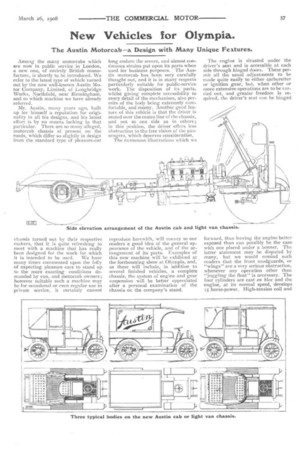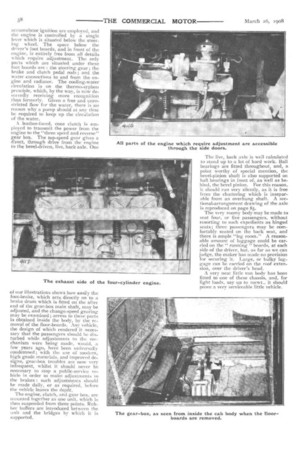New Vehicles for Olympia.
Page 3

Page 4

If you've noticed an error in this article please click here to report it so we can fix it.
The Austin Motorcab—a Design with Many Unique Features.
Among the many motorcabs which are now in public service in London, a new one, of entirely British manufacture, is shortly to be introduced. We refer to the latest type of vehicle turned Out by the now well-known Austin Motor Company, Limited, of Longbridge Works, Northfield, near Birmingham, and to which machine we have already referred.
Mr. Austin, many years ago, built up for himself a reputation for originality in all his designs, and his latest effort is by no means lacking in that particular. There are so many alleged, motorcab chassis at present on the roads, which differ so slightly in design from the standard type of pleasure-car chassis turned out by their respective makers, that it is quite refreshing to meet with a machine that has really been designed for the work for which it is intended to be used. We have many times commented upon the folly of expecting pleasure cars to stand up to the more exacting conditions demanded by van, and motorcab owners; however suitable such a machine may be for occasional or even regular use in private service, it certainly cannot long endure the severe, and almost continuous strains put upon its parts when used for business purposes. The Austin motorcab has been very carefully thought out, and it is in many respects particularly suitable for public-service work. The disposition of its parts, whilst giving complete accessibility to every detail of the mechanism, also permits of the body being extremely comfortable, and roomy. Another goad feature of this vehicle is that the driver is seated over the centre line of the chassis, and not to one side as in others ; in this position, the driver offers less obstruction to the free vision of the passengers, which deserves consideration.
The numerous illustrations which we reproduce herewith, will convey to our readers a good idea of the general appearance of the vehicle, and of the arrangement of its parts. Examples of this new machine will be exhibited at the forthcoming show at Olympia, and, as these will include, in addition to several finished vehicles, a complete chassis, the system of engine and gear suspension will be better appreciated after a personal examination of the chassis on the company's stand. The engine is situated under the driver's seat and is accessible at each side through hinged doors. These permit all the usual adjustments to be made quite easily to either c,arburetter or ignition gear, but, when other or more extensive operations are to b-e carried out, and greater freedom is required, the driver's seat can be hinged
forward, thus leaving the engine better exposed than can possibly be the case with one placed under a bonnet, The latter statement may be disputed by many, but we would remind such readers that the front mudguards, or "wings" are a very serious obstruction, whenever any operation other than "joggling the float" is necessary. The four cylinders are cast en bloc and the engine, at its normal speed, develops 15 horse-power. High-tension coil and accumulator ignition are employed, and the engine is controlled by a single lever which is situated below the steering wheel. The space below the driver's foot boards, and in front of the engine, is entirely free from all details which require adjustment. The only parts which are situated under these foot boards are : the steering gear ; the brake and clutch pedal rods ; and the water connections to and from the engine and radiator. The cooling-water circulation is on the thermo-syphon principle, which, by the way, is now deservedly receiving more recognition than formerly. Given a free and unrestricted flow for the water, there is no reason why a pump should at any time be required to keep up the circulation of the water.
A leather-faced, cone clutch is employed to transmit the power from the engine to the "three speed and reverse" gear box. The top-speed gear gives a direct, through drive from the engine to the bevel-driven, live, back axle. One
of our illustrations shows how easily the foot-brake, which acts directly on to a brake drum which is fitted on the after end of the gear-box main shaft, may be adjusted, and the change-speed gearing may be examined; access to these parts is obtained inside the body, by the removal of the floor-boards. Any vehicle, the design of which rendered it necessary that the passengers should be disturbed while adjustments to the mechanism were being made, would, a few years ago, have been universally condemned ; with the use of modern, high grade materials, and improved designs, gear-box troubles are now very infrequent, whilst it should never be necessary to stop a public-service vehicle in order to make adjustments to the brakes .: such adjustments should be made daily, or as required, before the vehicle leaves the depot.
The engine, clutch, and gear box, are mounted together as one unit, which is then suspended from three points. Rubber buffers are introduced between the unit and the bridges by which it is supported.
The live, back axle is well calculated to stand up to a lot of hard work. Ball bearings are fitted throughout, and, a point worthy of special mention, the bevel-pinion shaft is also supported on ball bearings in front of, as well as behind, the bevel pinion. For this reason, it should run very silently, as it is free from the chattering which is inseparable from an overhung shaft. A sectional-arrangement drawing of the axle is reproduced on page 85. The very roomy body may be made to seat four, or five passengers, without resorting to such expedients as hinged seats; three passengers may be comfortably seated on the back seat, and there is ample "leg room." A reasonable amount of luggage could be carried on the " running "boards, at each side of the driver, but, as far as we can judge, the maker has made no provision for securing it. Large, or bulky luggage can be carried on the roof extension, over the driver's head.
A very neat little van body has been fitted to one of these chassis, and, for light loads, say up to tocwt., it should prove a very serviceable little vehicle.




































